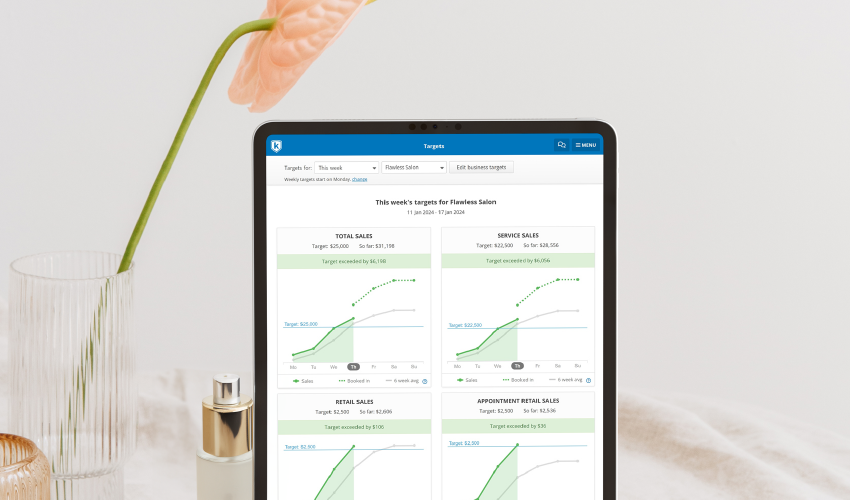Targets are a key component of a profitable and successful business. They motivate and focus your team to achieve goals that can grow your salon, spa or clinic and drive more revenue.
However, if you’re finding setting targets difficult to get your head around, this short guide to targets will demystify service and retail targets and help you get started!
Here we cover all your burning questions about setting sales targets in the hair and beauty industry, as well as what you need to think about when setting targets for your team.
How to choose which targets to track
When identifying which targets to track, there are two key things you need to think about:
- What are your overall business goals?
- Are there areas in your business you can improve?
It’s then a matter of determining which targets will drive your team towards achieving your business goals and the targets that will focus your team’s energy on addressing areas that require improvement.
For example, if your client rebooking rate is below 70%, there’s opportunity for improvement. Provide your team with some training and tips on how to rebook their clients, and set a motivating yet attainable rebooking target that will help you achieve your rebooking goal.
Do I need both business and staff targets?
It’s really up to you! You can choose to only have business targets in order to formalise your business goals, easily track progress or, if you employ a manager, as a way to motivate them.
If you decide to only set targets for your staff, they’re a great way to motivate, inspire and empower your team. However, blending both business and staff targets can be a powerful combination!
Your business targets are the big-picture goals that will shape the direction of your salon, spa or clinic, and the combination of each staff member’s performance and achievement of their targets is what will ultimately help reach your business targets.
How to determine if you need weekly or monthly targets
The importance of putting a timeframe on targets can’t be underestimated. Setting weekly or monthly targets will:
- Create focus and help your team to concentrate their efforts.
- Motivate your staff to work hard to reach their targets.
- Enables you to correctly determine if the target has been achieved.
Choosing between weekly and monthly targets is really about deciding what will suit your business best.
Here are key questions to ask yourself to help you decide:
1. What timeframe do you put on your business targets?
It may be easier to do the same with staff targets.
2. What would best motivate your team?
Will they work harder if they have less time to achieve a target or are they good at playing the long game?
3. How are they rewarded for achieving their targets?
Do they receive a weekly incentive or are they paid commission monthly?
4. How frequently do you review targets?
Do you prefer to look at them often or set a monthly meeting?
How to calculate targets
1. Begin by calculating a revenue target for the year.
Start at a business level. You could forecast this by looking at your revenue from the previous year (you can find this in the Business Summary Report in Kitomba). Then, based on your goals, determine how much you’d like to strive to make this year.
Alternatively, look at your expenses (rent, wages, stock) to determine how much it costs to run your salon each year. Based on that figure, you can calculate a profit goal that provides you with a revenue target.
2. Work out your monthly revenue target.
Remember to take into account fluctuations in the year, for example, the busy Christmas season or quiet winter period.
If you’ve chosen to set weekly targets, you can also break this down into weekly revenue figures. Then make sure to determine what split of your revenue will come from services and retail.
3. Calculate staff targets
Your staff targets should align with your business targets. For example, if your business target is $10,000 revenue per week, and you’re a salon with four staff members, each individual needs to make $2,500 a week on average.
However, you need to take into account everyone is different. By creating individual targets based on skills, experiences and pricing, it ensures targets feel realistic and drive staff to deliver the results you want.
For example, if you have an apprentice, two senior stylists and, as the owner, you work 20 hours a week, it might not be realistic to divide the weekly business target by four.
Instead you may determine your two seniors can make $3,500 per week, with 20 hours, similar experience and pricing you can make $1,750, and your apprentice with less appointments, experience and lower pricing, could achieve a target of $1,250. Ultimately, this still achieves your $10,000 revenue per week target.
Targets can be extremely impactful on both your staff and your salon in general when done right – we spoke with Paul Carbis about the importance of not only setting targets for your business and team, but also how to ensure they’re set and implemented correctly, and how to help your team achieve them. He recommends achievable, timely, relevant, and realistic targets for your team. Read the full blog here.
How do I track targets for my salon, spa or clinic?
To effectively set and keep track of targets for your salon, spa or clinic with as little admin as necessary, invest in specialised software that will enable you to easily set your targets and create reports at the click of a button.
Kitomba Salon and Spa Software allows you to track seven different targets:
- Total sales
- Service sales
- Retail sales
- Appointment retail sales
- Total appointment value
- Average appointment value
- Client rebooking
Each target can be set weekly or monthly, depending on what suits your goals and team. If you’re using targets to base a commission structure for your staff, you may want to align the target period with your commission period.
See more about using incentivising your staff targets here.
Your staff will also be able to track their personal targets using Kitomba 1. Once individual targets are set, use your business settings to grant access to each staff member for their targets – you can also control which staff have access to the business targets here. Being able to physically see how they are tracking is a great way to motivate your staff into upselling, and promoting rebooking culture in your business.
What’s next?
Now that you know how to set targets for services and retail in your salon, spa or clinic, the next step is introducing targets into your business by getting your team on board! For more advice on how to do this, read How to introduce targets into your team.
Do you have Kitomba targets set up? Get started in Kitomba 1 now, read our support guides on setting up Kitomba Targets, or contact our friendly support team for further assistance.
If you are not yet a Kitomba customer and would like a free demo of our software, including the targets feature, book here.
Read more about motivating and focusing your team, and ultimately growing your business in our comprehensive Salon Business Management Guide.
Editor’s note: This post was originally published on 19 Feb 2018 and has been updated for accuracy and comprehensiveness.
Read next:







